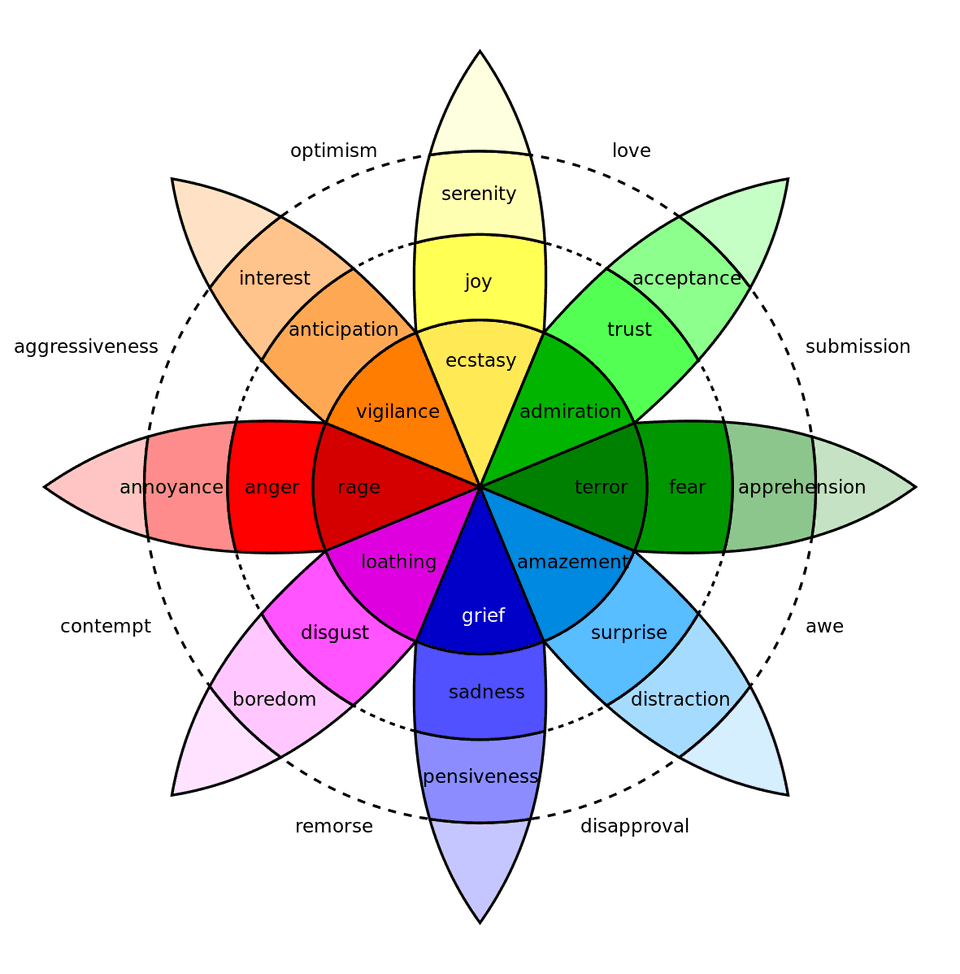Why Emotions Are Crucial in Feedback Processing?
In a scientific context, emotions are a complex behavioural phenomena that involves multiple levels of neural and chemical integration. In simpler terms, we can say that emotions are an instinctive way of alerting us to significant events. They arise involuntarily and unexpectedly. We don't choose to experience them, they simply happen to us spontaneously.
Emotions, both basic and complex, may have an emotional tone that can be either positive (e.g. joy, contentment, sadness) or negative (e.g. disgust, frustration, happiness). Research indicates that emotions can yield both positive and negative outcomes simultaneously, sometimes leading to conflicting consequences. While certain emotions are typically viewed as positive and desirable, such as happiness, studies have unveiled potential downsides to these emotions. Both "positive" and "negative" emotions have yet their place in our lives and can serve different functions. Negative feelings may seem challenging, but they serve as a signal that something isn't right and help us understand our needs.
In any feedback process emotions play a significant role regardless of whether you are a feedback giver or a receiver. They can engage individuals in your messages more effectively. They capture attention and foster a deeper understanding of the message, leading to better results. Let us now dive into emotional landscape bit deeper and discover the true potential that lies behind it.
how many emotions do we have?
Different theories offer varying perspectives on how to categorize emotions and how many emotions we can recognise. Some propose the existence of eight fundamental emotions, while others argue for a more extensive range.
According to the discrete emotion theory, the Differential Emotions Scale recognises 12 separate emotions. However, the recent research from the University of California, Berkeley, reveals a more extensive spectrum of emotions, pinpointing 27 distinct categories. This comprehensive analysis involved the study of thousands of individuals, scrutinizing their reactions to a variety of stimuli, such as videos, music, and diverse situations, to identify genuinely unique emotional categories.
What is interesting, Paul Ekman, an American psychologist and professor emeritus at the University of California, discovered that emotions such as joy, anger, disgust, sadness, fear, and surprise (and later added contempt) are universally recognised across different cultures. In his research he used short stories and images of emotional faces to understand the universality of emotional expression, developed later into the Facial Action Coding System.
On the other hand, Robert Plutchik, a psychologist specializing in emotions, developed the wheel of emotions, which comprises eight basic emotions: joy, sadness, trust, disgust, fear, anger, surprise, and anticipation. According to Plutchik, these basic emotions can combine to create complex emotions, such as love (a combination of trust and joy) or embarrassment (a combination of fear and surprise). The model illustrates how emotions function, defining their placement on the wheel, which indicates their intensity and opposites. Half of these emotions are considered positive, and the other half are considered negative. They are perceived as opposites of each other.

Source: https://commons.wikimedia.org/wiki/File:Plutchik-wheel_es.svg
For instance, joy is opposite to sadness, surprise is contrary to impatience, trust opposes disgust, and anger is opposite to fear. Plutchik elaborated on each emotion in detail and divided them into primary, secondary, and tertiary subgroups. His model describes a fascinating relationship between emotions, their intensity, and polarization. In Plutchik's model, the intensity of emotions is high when they are located at the center of the wheel and decreases as the distance from the center increases. Furthermore, Plutchik's Wheel of Emotions demonstrates that basic emotions can combine to form more complex emotions.
In fact, our capacity for diverse emotional encounters is dependent on the size of our emotional vocabulary. Reflect on your personal encounters – it's often exasperating when you struggle to articulate your emotions effectively. You might opt for the readily available term: “I’m angry at you." Yet if you pause for a moment and scan your mental library of emotions, you might uncover a richer assortment of words to convey your sentiments: hurt, undermined, insulted, neglected, or provoked.
why do we need emotions in feedback process
Emotions play a crucial role in feedback processing for several reasons:
🚀 Motivation
Emotions like enthusiasm or satisfaction can motivate individuals to continue their current behaviours or make improvements. Conversely, emotions like disappointment or frustration can prompt them to address areas of concern.
🧠 Memory and Learning
Emotions can enhance memory and learning. Feedback received with some emotional reinforcement is more likely to be remembered, making it easier to implement changes or take action based on the feedback.
🤝 Engagement
Emotionally charged feedback can engage individuals more effectively. It captures their attention and fosters a deeper understanding of the message.
🏞 Perspective
Emotions can help you see feedback in a broader context. Positive emotions can encourage you to recognise strengths, while negative emotions can prompt you to see areas that require improvement.
🗣Communication
Emotions can influence how feedback is delivered and received. Effective feedback should consider the emotional state of the recipient to ensure it is well-received and acted upon.
how can I use emotions in feedback process
When used effectively, emotions can largely enhance the feedback communication process. But instead of making other people guess your emotions, it is much easier to tell about them. If you are the feedback giver, you should particularly be aware of the emotions you are going to inform about. Don’t be emotional, but talk about emotions you have been experiencing.
Take a look at three examples of feedback message according to FECE (Facts, Emotions, Consequences, Expectations) Feedback Model by Jurgen Appelo that involve information about emotions:
1. Situation: Your colleague helped you resolve a critical bug just before a project deadline.🥳
Facts: "You provided a quick solution for the bug just before the project deadline." Emotions: "I felt relieved and grateful for your quick response." Consequences: "This greatly contributed to the successful project completion and saved us time and stress." Expectations: "I look forward to doing some next project with you. Teamwork makes the dreamwork. Great job!"
2. Situation: Your colleague's frequent tardiness is causing delays in the project.😰
Facts: "I've noticed that you've been late for several meetings and project milestones." Emotions: "I'm concerned and annoyed at the same time because it has become a recurring issue." Consequences: "This delay affects our project's timeline and team productivity in a negative way.” Expectations: “It would be great if we can talk about that and resolve this issue to improve yours and at the same time our team's performance."
3. Situation: Your colleague failed to communicate about a roadblock which led to misunderstandings.😓
Facts: “I want to understand why yesterday you didn’t communicate at daily meeting that you were having some roadblock in your task.” Emotions: “I am a bit disappointed and confused by this situation." Consequences: “As this leads both to misunderstanding with our client and delay of the delivering the whole feature.” Expectations: "I want us to establish a better process for sharing roadblocks and challenges to prevent such issues in the future. Do you have any ideas how we can work on this or how can I help you with that?"
Using the above feedback messages incorporate facts, consequences and expectations, but there is also space for expressing emotions so that the whole meaning is much clearer to the recipient. Emotions add a human touch to your feedback. Recognising and addressing emotions acknowledges that we are not just interacting with robotic entities but with fellow humans who have feelings. Emotions also help explain the impact of the behaviour or situation on the giver of feedback. Sharing emotions can lead to a better understanding of the feedback's significance and why it matters. They make feedback more genuine and authentic.
summary
In the realm of feedback, emotions are the bridge that connects us on our journey toward growth and understanding. They infuse our words with empathy, our intentions with sincerity, and our actions with purpose. As we navigate the intricate landscape of human interactions, let us not forget about the power emotions wield in the feedback process.
Next time you find yourself offering or receiving feedback, consider the emotional undercurrents at play. Acknowledge them, embrace them, and allow them to be your compass in building stronger, more empathetic relationships. In doing so, we can create a world where feedback isn't just about pointing out flaws or celebrating successes but about the true connections we forge and the collective progress we achieve. The path to better feedback is a journey worth embarking upon, hand in hand, with our emotions as our guides.
